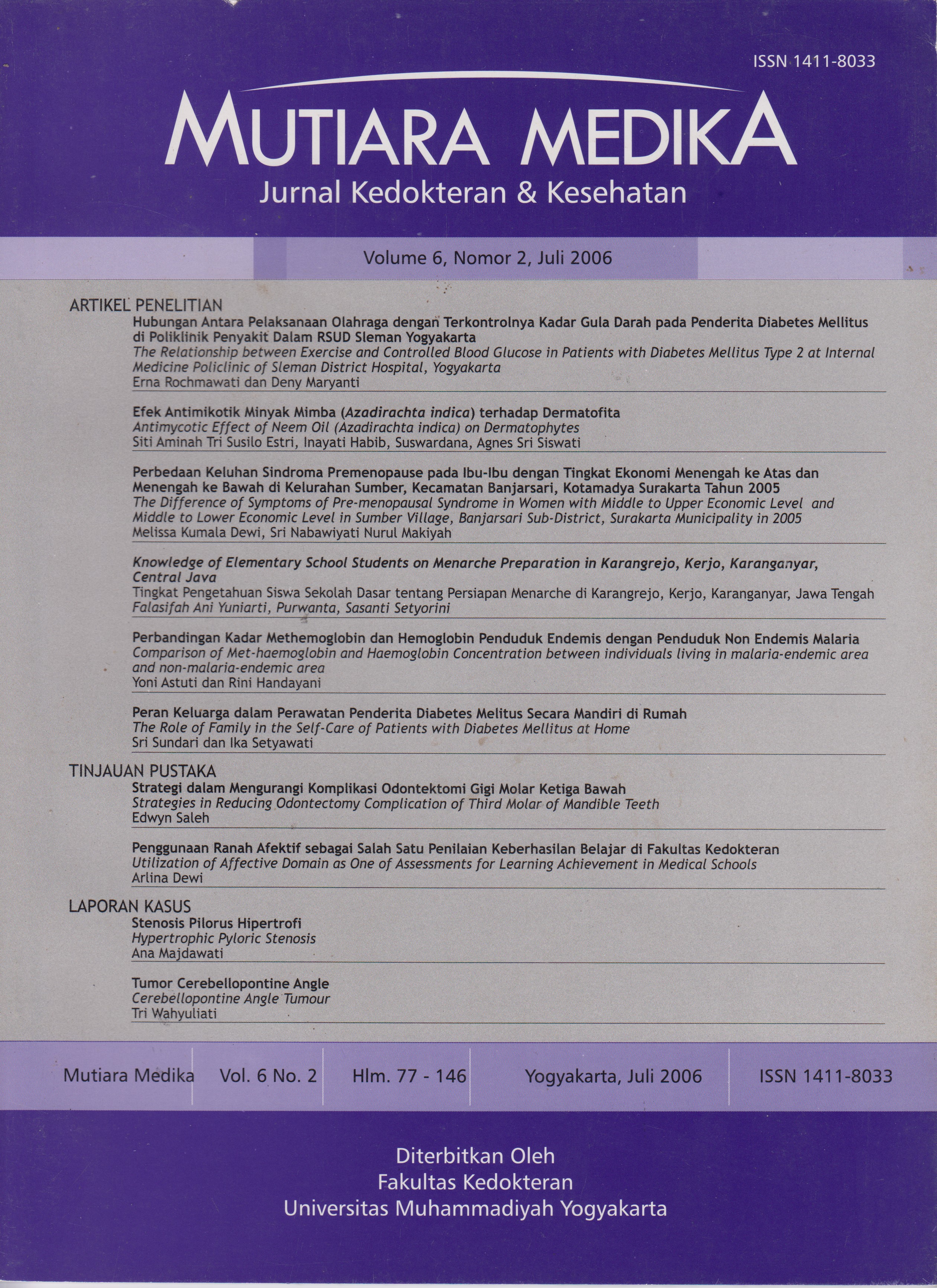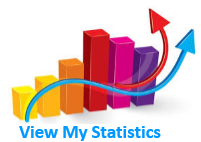Perbandingan Kadar Methemoglobin dan Hemoglobin Penduduk Endemis dengan Penduduk Non Endemis Malaria
DOI:
https://doi.org/10.18196/mmjkk.v6i2.1895Keywords:
hemoglobin, malaria, methemoglobin, haemoglobin, met-haemoglobinAbstract
One of the effects of Plasmodium infection and consumption of anti-malaria medicine is the increase of free radicals in the body. Free radicals can attack haemoglobin and change it to met-haemoglobin. The aim of this study was to identify the concentration of met- haemoglobin (as a sign of free radicals) and haemoglobin of individuals living in the malaria- endemic area as compared with individuals living in non-malaria-endemic area.This was a cross sectional study. Subjects of the study were 60 individuals and divided into 2 groups, i.e. Endemic Group (EG) and Non-Endemic Group (NEG). The EG included 30people who were men and women between 20-50years old, had suffered or were suffering from malaria and had been living in endemic area for five years. The NEG included 30 people who were men or women between 20-50 years old and had not suffered from malaria. The blood samples were collected and analysed for met-haemoglobin concentration using Betke method and haemoglobin concentration using cyanmethaemoglobin method.
The results showed that the average of met-haemoglobin concentration of NEG was (2,188 ± 0,662)% and EG was (3,728 ± 0,492)%, while the average of haemoglobin concentration of NEG was (14, 183 ± 2,593)g% and EG was (10,376 ± l,447)g%. This demonstrated that the concentration of haemoglobin between NEG and EG was different significantly (p<0,05).
Salah satu akibat terinfeksi plasmodium dan dampak mengkonsumsi obat - obatan menyebabkan meningkatnya radikal bebas. Radikal bebas dapat menyerang haemoglobin sehingga menj adi methemoglobin. Tujuan penelitian ini adalah untuk mengetahui kadar methemoglobin (sebagai marker radikal bebas) dan hemoglobin penduduk endemis malaria dibandingkan dengan kadar methemoglobin penduduk non endemis.
Penelitian ini adalah penelitian cross sectional dengan subyek sebanyak 60 orang dibagi menjadi 2 kelompok. Kelompok endemik malaria sebanyak 30 orang yaitu laki-laki dan wanita berumur20-50 tahun yang pernah atau sedang menderita malaria dan telah tinggal di daerah endemis selama minimal lima tahun. Kelompok non endemik malaria sebanyak 30 orang yaitu laki-laki dan wanita berusia 20-50 tahun yang tidak pemah menderita penyakit malaria. Subyek diambil darahnya dan selanjutnya dilakukan analisis kadar methemoglobin menurut metode Betke, dan diukur kadar hemoglobin dengan metode cyanmethemoglobin.
Hasil penelitian menunjukkan bahwa persentase methemoglobin KNE (Kelompok Non Endemis) adalah (2,188 ± 0,662) % Hb dan KE (Kelompok Endemis) adalah (3,728 ± 0,492) % Hb. .Hasil penelitian kadar hemoglobin menunjukkan bahwa persentase hemoglobin KNE adalah (14,183 ± 2,593) g % dan KE adalah (10,376 ± 1,447) g %. Hal itu memperlihatkan adanya perbedaan signfikan antara KNE dan KE (p<0,05).
References
Suwasono H, dkk. 1999 . Kejadian Luar Biasa (KLB) Malaria di Puskesmas Kalibawang Kabupaten Kulonprogo DIY tahun 1998, Media Medika Indonesiana, vol. 34, No. 3 : 113-121, FK UNDIP Semarang.
Harijanto PN. 1999. Malaria : Epidemiologi, Patogenesis, Manisfestasi Klinis dan Penanganan, Cetakan 1, Buku Kedokteran EGC, Jakarta.
Coleman MD, Coleman, NA 1996. Drug induced Methaemoglobinaemia, Treatment issues, Drug Saf. 14.6 : 394- 405.
Bruckner D A, Garcia L S 1996 . Diagnostik Parasitologi Kedokteran, Buku Kedokteran EGC, Jakarta hal 81- 96.
Fairbanks VF, Klee, GG 1986. Biochemical Aspects of Hematology, in Tietz, N.W. (edj, Textbook of Clinical Chemistry, W.B. Saunders Company, pp. 1536-37.
Mansouri AL 1993. Concise Review : Methaemoglobinemia, Am. J. Haematol. 42:7-12.
Flehn W. 1991. Concentration of Methemoglobin in Blood under Phisiologycal and Pathological Condition, in Zander, Mertzlufft (ed.), The Oxygen Status of Arterial Blood, Korger, Basel, pp. 190-5.
Schwartz JM, Reiss AL, Jaffe ER1983. Hereditary Methaemoglobinaemia with Deficiency of NADH-Cytochrome b5 Reductase, in Stanbury, J.B., Wyngaarden, J.B., Fredrickson, D.S., Goldstein, J.L., Brown, M.S (ed.), The Metabolic Basis of inherited Disease, 5thed., McGraw-Hill Book, New York, pp. 1654-65.
Widmann FK 1983. Clinical Interpretation of Laboratory Test, 9th, pp. 31-44, EGC, Jakarta.
VarleyH 1986. Practical Clinical Biochemistry, 4th Edition, The English Language Book Society and William Heinmann Medical Books LTD., London.
Downloads
Issue
Section
License
Copyright
Authors retain copyright and grant Mutiara Medika: Jurnal Kedokteran dan Kesehatan (MMJKK) the right of first publication with the work simultaneously licensed under an Attribution 4.0 International (CC BY 4.0) that allows others to remix, adapt and build upon the work with an acknowledgment of the work's authorship and of the initial publication in Mutiara Medika: Jurnal Kedokteran dan Kesehatan (MMJKK).
Authors are permitted to copy and redistribute the journal's published version of the work (e.g., post it to an institutional repository or publish it in a book), with an acknowledgment of its initial publication in Mutiara Medika: Jurnal Kedokteran dan Kesehatan (MMJKK).
License
Articles published in the Mutiara Medika: Jurnal Kedokteran dan Kesehatan (MMJKK) are licensed under an Attribution 4.0 International (CC BY 4.0) license. You are free to:
- Share — copy and redistribute the material in any medium or format.
- Adapt — remix, transform, and build upon the material for any purpose, even commercially.
This license is acceptable for Free Cultural Works. The licensor cannot revoke these freedoms as long as you follow the license terms. Under the following terms:
Attribution — You must give appropriate credit, provide a link to the license, and indicate if changes were made. You may do so in any reasonable manner, but not in any way that suggests the licensor endorses you or your use.
- No additional restrictions — You may not apply legal terms or technological measures that legally restrict others from doing anything the license permits.






